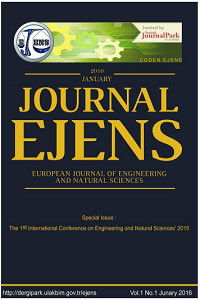Determination of The Hip Stem Loosening Using Vibration Method
Determination of The Hip Stem Loosening Using Vibration Method
___
- [1]. H. Malchau, P. Herberts, T. Eisler, G. Garellick, and P. Soderman, "The Swedish Total Hip Replacement Register " J. Bone Joint Surg. Am., vol. 86-A, pp. 2-20, 2002.
- [2]. K. E. Dreinhofer, "Indications for total hip replacement: comparison of assessments of orthopaedic surgeons and referring physicians," Annals of the Rheumatic Diseases, vol. 65, pp. 1346-1350, 2006.
- [3]. A. P. Georgiou and J. L. Cunningham, "Accurate diagnosis of hip prosthesis loosening using a vibrational technique," Clinical Biomechanics, vol. 16, pp. 315-323, 2001.
- [4]. L. C. Pastrav, S. V. N. Jaecques, I. Jonkers, G. Perre, and M. Mulier, "In vivo evaluation of a vibration analysis technique for the per-operative monitoring of the fixation of hip prostheses," Journal of Orthopaedic Surgery and Research, vol. 4, p. 10, 2009.
- [5]. J. S. Rieger, S. Jaeger, C. Schuld, J. P. Kretzer, and R. G. Bitsch, "A vibrational technique for diagnosing loosened total hip endoprostheses: An experimental sawbone study," Medical Engineering & Physics, vol. 35, pp. 329-337, 2013.
- [6]. A. A. Alshuhri, T. P. Holsgrove, A. W. Miles, and J. L. Cunningham, "Development of a non-invasive diagnostic technique for acetabular component loosening in total hip replacements," Medical Engineering & Physics, vol. 37, pp. 739-745, 2015.
- Başlangıç: 2015
- Yayıncı: CNR Çevre
Koray KARABULUT, Dogan Engin ALNAK, Ferhat KOCA
Developments and Applications in Enzyme Activated Membrane Reactors
Nadir DİZGE, Ruken Esra DEMİRDOGEN, Kasım OCAKOGLU
Investigation of Notch Root Strain Behaviors Under Combined Loadings
Toros Arda AKSEN, Emre ESENER, Mehmet FIRAT
Generation of a Multi-Layered Diffusion Coating on an Interstitial-Free Steel
Fikri Erdem Şeşen, Ömer Serdar Özgen
Development of Ecological Biodesign Products by Bacterial Biocalcification
Tuğba Keskin Gündoğdu, İrem DENİZ, Alpcan ARİC, Burak Talha YILMAZSOY, Ozge ANDİC CAKİR, Aysegul ERDOGAN, Didem ALTUN, Ayca TOKUC, Burcu Filiz DEMİRCİ, Aylin SENDEMİR, Gulden KOKTURK, Feyzal Ozkaban
The Abrasion Resistance of Mortars Containing Natural Zeolite Analcime
Yahya BOZKURT, Adnan TÜRKER, Gamze SOYTEMİZ, Serdar SALMAN
An Alternative Method for Long-Term Land Cover Change Detection: A Case Study of Hasanlar Dam
Firat Caglar Yilmaz, Sukran Sahin
Wastewater Treatment by Floating Macrophytes (Salvinia Natans) Under Algerian Semi-Arid Climate
Laabassi AYACHE, Boudehane ASMA
The Usage of Modified Chitosan for the Removal of Hexavalent Chromium from Waste Water
